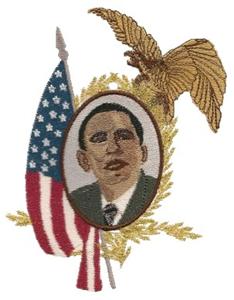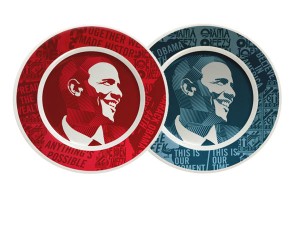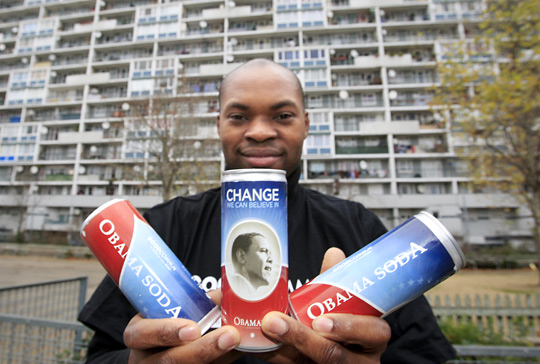
Mr. Portigal (thanks!) points out this Metafilter post that I’d missed:
In the capital of Turkmenistan stands an enormous statue of a book. Every evening at 8PM, the statue swings open and a recently deceased dictator’s magnum opus, the Ruhnama, is broadcast throughout the square while a video from within the statue shows his image.
The post links to a documentary maybe by Finnish filmmakers and available on YouTube in 10 parts. I did not watch the whole thing. In this part, however, at about the 4:35 mark, there’s some twilight / nighttime footage of the book swinging open. I know precisely zero about the rather dodgy-sounding politics here, but an immense book that swings open, onto which video images are projected, is fascinating.

Click to see YouTube video; I’ve punched up this image a little.
This post is part of a series.

Maybe you’re aware of the controversy about this map. If you’re not: What does it communicate to you, visually? Does it look like a graphic from some movie about a violent assault on the United States? Or just a mundane political-strategy graphic?
If you are aware of the controversy, then you know that’s pretty much what he controversy boils down to. The full map below was published on Sarah Palin’s Facebook page, and critics say it’s sending a dangerous visual message in a moment when lawmakers are reportedly receiving death threats about their positions on health care reform. Palin, I gather, says such critics are making a phony argument and the imagery is benign.
An interesting design-interpretation disagreement. And one that seems pretty hard to hash out, because it’s hard for any observer, I suspect, to separate what one sees from one’s politics.


Okay well I just said I wasn’t going to offer an aesthetic critique of the new recovery logo. But, since McChris, in the comments, mentioned the National Recovery Act emblem from the Great Depression/New Deal era and even offered an image link … Well, I can’t help but say that I think there’s a boldness in the old emblem that’s definitely not present in the new one. The new one seems a bit wimpy to me, a bit, I don’t know, Facebooky or something — or like it represents an iPhone app. It also strikes me as a little too busy for its own good.
BUT, maybe my view will change in time. Again I think it does its job only via repetition and context. So … we’ll see.
Anyway what seeing this old emblem really makes me wonder is: Why in the world didn’t the Obama team hire Shepard Fairey to do the new recovery logo? Whether you’re pro or con Fairey, you’ve got to admit: The guy really knows how to do propagandistic icons.
[3/5 UPDATE: I really have nothing to say today, so instead read Brian’s comment on government iconography below, as it is superior to the post itself. Oh, and here, via Design Observer‘s “observed” links, is info on who designed the new recovery logo. I’m going to guess that when the design blogs get to assessing (I still haven’t seen any writeups), they will generally like it. But maybe not. Very curious to know… ]
 WSJ:
WSJ:
At the Department of Transportation Tuesday, Mr. Obama unveiled a new logo for projects funded by his $787 billion stimulus plan and announced the first infrastructure project to receive funds.
The logo — with a three-leafed sprig for green jobs, a set of gears for infrastructure, and “recovery.gov” beside a field of stars — will be used to brand projects as well as raise the visibility of the White House’s economic initiatives and try to dramatize their impact.
This is interesting and I think it’s potentially smart. I’ll leave it to others to critique the actual design — and I expect there will be plenty of critiques. But as is so often the case with logos (including the vaunted Obama campaign logo), what will really matter won’t be simply aesthetics, but repetition and context. If people really start to see this a lot, connected to actual work being done, it will have the desired effect: “Wow, that stimulus money is making things happen.”
 … but, for reasons that would take too long to explain, I was just on a site called Embroidery.com, and was surprised to see that the “most popular” embroidery pattern on offer was, yes, “President Obama Commemorative Embroidery.” Or “POOBAMA 1,” as the product reference code puts it.
… but, for reasons that would take too long to explain, I was just on a site called Embroidery.com, and was surprised to see that the “most popular” embroidery pattern on offer was, yes, “President Obama Commemorative Embroidery.” Or “POOBAMA 1,” as the product reference code puts it.
I don’t have time to look up the links, but shortly after the election I remember a few non-Obama-fan Web commentators suggesting that all the posters and whatnot created by Barackist artists and designers would end up taking on the quality of totalitarian propaganda. I didn’t, and don’t agree (unless the much-awaited stimulus plan includes a government-sponsored proBama postering campaign).
However … the other day, looking at stuff like this with E, it wasn’t hard to imagine another fate for the massive glut of Obamafied artifacts: future kitsch. I think the thrift stores of the future will have shelves and shelves of this stuff.
Possibly that same idea is implied by The Future Perfect’s offering of Obama commemorative plates designed by Shepard Fairey.

Or possibly not. I’m not sure.
Anyway, here’s a painting of Obama, nude, riding a unicorn.
By now somebody must have observed that the Obama economic stimulus plan is clearly premised on (frugal?) consumers buying an absolutely unlimited amount of Obama tchotchkes.
Here is Slate’s slideshow with some examples. Sadly not mentioned: The “Obama Victory Mugs” ($24.95 for a set of two), “Keepsake T-Shirt” ($32.95), and copies of tomorrow’s newspaper (order now!) on offer in the Barack Obama section of the New York Times online store.
In other Obama-culture news, Studio 360 did a segment on Obama art this weekend. April 13, 2008 Consumed on that subject is here. Not enough Obama for you? Link roundup on Obama art and products and marketing here. Search this site for “Obama” for even more.

Wish I could find more images online from this book: “Off The Wall: Political Posters of the Lebanese Civil War.”
The Economist says:
IF THE devil has the best tunes, radicals make the best posters. In Lebanon the propaganda posters of Hizbullah and its allies are a heady mix of bright colour, simple logos and distinctively Arab calligraphy and portraits. The government commissioned Saatchi & Saatchi to make its case in 2006, but its advertising was never as striking as the humblest political placard from the Islamists.
The poster collection in “Off the Wall”, comes from the 20-odd factions of Lebanon’s 1975-90 civil war and shows that the shifting alliance of leftists and other radicals had artistic flair from the outset. Hizbullah, the Communists, the Syrian nationalists and the PLO, among others, harnessed contemporary graphic design and made it their own: Jerusalem in glowing colours features alongside clenched fists and AK-47s; the four-sided Syrian symbol rises like a sun; car bombs go bang like Roy Lichtenstein paintings.

Obama Soda, available in France — proof that the French really do know the meaning of the word entrepreneur (as the old joke goes). NPR story here.
So here’s an interesting exercise in attempting to reposition the symbolism of an unexpected incident.
Bush is over in Iraq, and a guy gets up and hurls his shoes at the president’s face, as hard as he can. Then he does it again. Bad PR moment!
But no. Bush says, “That’s what people do in a free society, draw attention to themselves.”
Condoleeza Rice says the incident “is a kind of sign of the freedom that people feel in Iraq.”
Excuse me? Do we enjoy our democracy by hurling objects at each other’s heads here in the Land of the Free? I’m pretty sure that if you go out and throw a shoe, or any similar item, at someone’s face, you’re going to be arrested. As well you should be! Throwing a shoe at someone’s face, even in America (even in your own home, for that matter) is not a sign of freedom, and it is not “what people do” in any free society. It’s attempted assault.
As for what happens when people like the show-thrower “draw attention to themselves” and how much it’s a “sign of freedom,” I think it’s worth considering the NYT’s deadpan description of what was happening while Bush riffed on the positive symbolism of the moment: Once the shoe-thrower was tackled and taken away by security, the President spun the incident away — “as the man’s screaming could be heard outside.”
Points for trying, though. I didn’t think there would be a way to reposition a guy throwing shoes at the President’s face as a victory for the American idea. But I guess there is.
Also, points to GWB for agility: He looked quite spry as he ducked that first shoe in particular. Here’s BoingBoing’s roundup of amusing GIF reactions — which is how we really express our freedoms in the home of the brave these days.
As a footnote to the other day’s post, and to the election, The Wealth Report notes that Obama “won 52% of the votes of those earning $200,000 or more. That compares with Sen. John McCain’s 46% showing for the same group.”
Why? Wealth Report offers three possibilities, truncated here (see the whole post for details):
First, the wealthy, like many voters, may have placed a higher emphasis on the state of the nation than the state of their wallets. …
Another possibility is that the wealthy don’t believe Sen. Obama will go through with his tax increase — at least not right away…
Finally (and perhaps least likely), the wealthy may be responding to Sen. Joe Biden’s argument that paying higher taxes is patriotic….
Country first!
… for best 2008 presidential election-inspired video on YouTube, is here. It’s only 2 and a half minutes, but it’s pretty great. It’s got my support.
The other day I noted the brand name-drops in a Times story about “Palin dudes” — Carhartt, John Deere. But what about Palin and her family? Politico offers some information, not so much about brands but at least about favored retail destinations:
The Republican National Committee has spent more than $150,000 to clothe and accessorize vice presidential candidate Sarah Palin and her family since her surprise pick by John McCain in late August.
According to financial disclosure records, the accessorizing began in early September and included bills from Saks Fifth Avenue in St. Louis and New York for a combined $49,425.74.
The records also document a couple of big-time shopping trips to Neiman Marcus in Minneapolis, including one $75,062.63 spree in early September. …
September payments were also made to Barney’s New York ($789.72) and Bloomingdale’s New York ($5,102.71).
The entries also show a few purchases at Pacifier, a top notch baby store, and Steiniauf & Stroller Inc., suggesting $295 was spent to accommodate the littlest Palin to join the campaign trail.
An additional $4,902.45 was spent in early September at Atelier, a high-class shopping destination for men.
Stimulating the economy, y’all.
So from everything I have read, Joe The Plumber would not, in fact, be fiscally penalized by an Obama administration. He does not actually, as he has conceded, make $250,000 a year. The plumbing business he supposedly wants to buy almost certainly does not net $250,000 a year. And in any case, his purchase of that business appears to be a pure hypothetical. If anything, it is likely that voting for Obama would be in Joe’s economic self interest: Joe himself admits that unless Obama is lying about his plans, “I would be receiving his tax cuts.”
This raises some questions. For starters, what is Joe’s problem? Is he stupid? Is he a Republican plant? Is he motivated by some other issue that has nothing to do with this?
Well, anything is possible. But I think Joe may be acting in the interest not of himself, but of a theoretical future self. When Joe told Obama “I’m being taxed more and more for fulfilling the American dream,” he was, objectively speaking, wrong. He is not being taxed more and more, because he is not fulfilling the American dream.
He is dreaming the American dream. And as it happens, there’s no charge for that. But while Joe would not be penalized by Obama’s proposed tax hikes, his theoretical future self — Dream Joe, let’s call him — would.
Or might be, if Dream Joe comes true. Of course Actual Joe is a true American, and believes that Dream Joe will inevitably merge with Actual Joe; it’s only a matter of time. So that was Dream Joe talking to Obama.
Anyway, the absurd Joe spectacle has me thinking about a bit from a recent George Packer New Yorker camapaign article. The article had Packer traveling around economically beaten-down areas talking politics, and the relevant passage deals with Thomas Frank’s What’s The Matter With Kansas, and that book’s thesis: Working-class people vote against their economic self-interest for cultural reasons that have been seized on and amplified by conservative politicians.
I’ll put the whole passage after the jump, but basically Packer summarizes research by some sociologists which suggested that working-class voters who used to see the Democratic party as a protector of their economic security started drifting away in the 1970s, not because of cultural issues, but precisely because in their judgment the Democratic party had lost the ability to protect that economic security — or their “material well-being,” as the study’s authors put it. After all, unions were dying out, jobs were going overseas, and these workers were increasingly on their own.
“Working-class whites, their fortunes falling, began to embrace the anti-government, low-tax rhetoric of the conservative movement,” Packer writes. (The cultural factors Frank cites kicked in later, according to this argument. See the whole passage for more.)
To this I’d just add one more layer, which will bring us back to the likes of Joe. The anti-government, low-tax rhetoric that Packer refers to — and that was perfected by Ronald Reagan, who managed to win the role of governing the citizenry in large part by arguing that government is the biggest problem citizens have — worked because it spoke to aspiration.
It was populist rhetoric, but it did turn not turn on class warfare. Indeed it did away with the idea that the Joe the Plumbers of the world resent the rich, and was rather premised on the insight that Joe the Plumber and his ilk want to be the rich. And in point of fact believes he ought to be rich, deserves to be rich. Taken to its extreme, this form of populist rhetoric is premised on class envy: Joe is as good as any of those fat-cat swells! What’s keeping him from being rich? The government! Outta the way, government!
Joe the Plumber identifies with that, even though, in real life, his “wealth” will not be “spread around” by an Obama government, or any government. Yet he is not interested in the best interest of Actual Joe; he is interested in the best interests of Dream Joe.
And he’s not alone. Which is why the McCain campaign has been attempting the neat rhetorical trick of suggesting that a tax increase for the top-earning 2% of Americans is actually a blow to the Joes of the world. Maybe I’ll say more about that tomorrow.
Extract from New Yorker article after the jump if you’re interested. Read more
The campaign wants “to hear from you and share your story with the American public. It’s simple … make an ad telling us why you are “Joe the Plumber” in 30 seconds and your video could end up on the air as a TV ad.”
- Be creative! The video that most effectively tells why you are Joe the Plumber will be featured in a TV ad.
- Tell us why you are like Joe the Plumber.
- How would Barack Obama’s plan to “Spread the Wealth Around” hurt you?
Etc.
Details here. Via The Stump.




 "
"






















 Kim Fellner's book
Kim Fellner's book  A
A